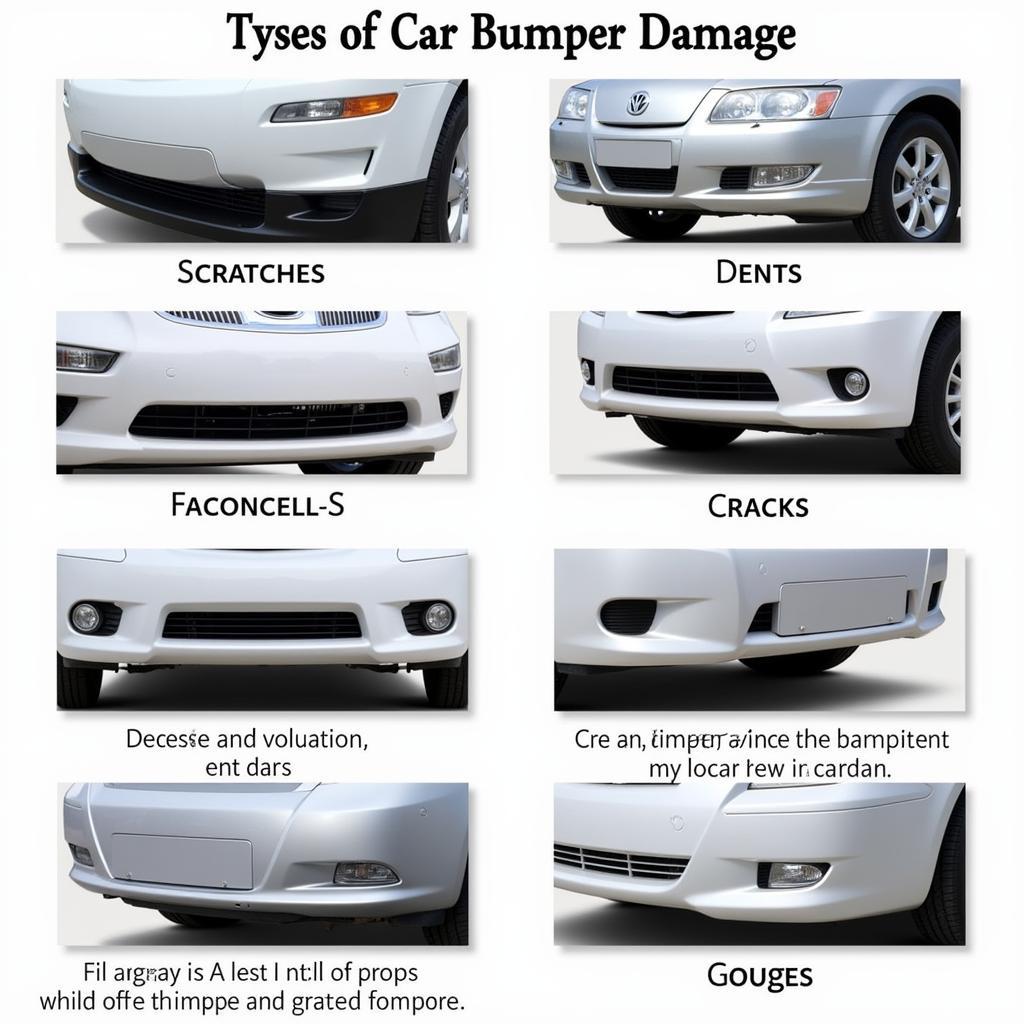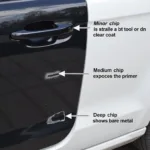Car bumper repair and paint is a common need for car owners. Whether it’s a minor scratch, a dent, or more significant damage, restoring your bumper’s appearance is crucial for maintaining your vehicle’s overall aesthetic and value. This guide will delve into the intricacies of car bumper repair and paint, offering valuable insights into the process, costs, and DIY options.
Understanding Car Bumper Damage
Bumpers are designed to absorb impact, protecting your car from more severe damage in collisions. However, this means they are prone to scratches, dents, and cracks. Understanding the type of damage is the first step in determining the appropriate repair method. Minor scratches might only require touch-up paint, while deeper damage may necessitate filling, sanding, and repainting. The material of your bumper also plays a role. Plastic bumpers are common and generally easier to repair than metal ones. Identifying the extent and type of damage will help you make informed decisions about the repair process. For information on repairing and painting rubber bumpers, check out this resource: repairing and painting rubber car bumpers a recommended repair.
Types of Bumper Damage
- Scratches: Superficial damage affecting only the clear coat or paint.
- Dents: Deformations in the bumper’s shape.
- Cracks: Breaks or splits in the bumper material.
- Gouges: Deep scratches that remove a significant portion of the bumper material.
Knowing the specific type of damage you’re dealing with will help you determine the right course of action.
DIY vs. Professional Car Bumper Repair and Paint
Deciding between a DIY repair and hiring a professional depends on several factors, including your skill level, the extent of the damage, and your budget. Minor scratches and scuffs can often be addressed with DIY repair kits. However, more complex damage, such as deep dents or cracks, requires specialized tools and expertise, making professional repair the preferred option. For more detailed information on car bumper and paint repair, see this article: car bumper and paint repair.
DIY Car Bumper Repair
DIY repair can be cost-effective for minor damage. It involves cleaning the area, sanding, applying filler if necessary, priming, painting, and applying a clear coat. Numerous online tutorials and resources provide step-by-step instructions.
Professional Car Bumper Repair
Professional car bumper repair ensures a high-quality, long-lasting finish. Professionals have the necessary equipment and expertise to handle complex repairs and color matching. They can also address underlying structural issues that DIY repairs might miss.
Cost of Car Bumper Repair and Paint
The cost of car bumper repair and paint varies depending on the extent of the damage, the type of bumper material, and the labor rates in your area. Minor repairs, like fixing scratches, can cost a few hundred dollars, while more extensive repairs, involving replacement parts and repainting, can range from several hundred to over a thousand dollars. For residents of Rogers, Arkansas, looking for specific pricing, you can find more information here: car paint and bumper repair rogers ar.
Factors Affecting Cost
- Severity of damage: Minor scratches are cheaper to repair than major dents or cracks.
- Bumper material: Plastic bumpers are typically less expensive to repair than metal ones.
- Labor costs: Labor rates vary by location and shop.
- Paint type: Specialized paint finishes can increase the cost.
Choosing the Right Car Paint
Selecting the correct car paint is crucial for a seamless repair. You need to match the existing paint color precisely. Automotive paint codes can be found on a sticker inside the driver’s side doorjamb or in your owner’s manual. This code helps ensure accurate color matching. Also, consider the type of paint—acrylic lacquer, acrylic enamel, or urethane—as each has different properties and application requirements. More information about car paint and bumper repair in Rogers can be found here: car paint and bumper repair rogers.
Tips for Choosing Car Paint
- Match the paint code: Use the manufacturer’s paint code for accurate color matching.
- Consider the paint type: Choose the appropriate paint type based on the original finish and your budget.
- Test the paint: Apply a small amount of paint to an inconspicuous area to ensure a perfect match.
Conclusion
Car bumper repair and paint are essential for maintaining your vehicle’s appearance and value. Understanding the types of damage, the repair options, and the associated costs will help you make informed decisions. Whether you choose a DIY approach or seek professional assistance, proper car bumper repair and paint will restore your car’s aesthetic appeal and protect it from further damage. Remember to consider the severity of the damage and your budget when making your decision. Need help with chipping car paint? Check this out: repair chipping car paint.
FAQ
- How long does car bumper repair and paint take? It depends on the extent of the damage, but typically ranges from a few hours to a couple of days.
- Can I repair a cracked bumper myself? Minor cracks can sometimes be repaired with DIY kits, but larger cracks often require professional repair.
- How do I find my car’s paint code? The paint code is usually located on a sticker inside the driver’s side doorjamb or in your owner’s manual.
- What is the best type of paint for car bumper repair? Urethane paints are generally preferred for their durability and resistance to chipping.
- How much does it cost to repaint a whole bumper? The cost varies depending on the factors mentioned earlier, but it can range from a few hundred to over a thousand dollars.
- How can I prevent future bumper damage? Careful parking, avoiding low-hanging obstacles, and installing bumper protectors can help prevent future damage.
- What should I do after a minor bumper scrape? Clean the area thoroughly and assess the damage to determine the necessary repair.
Common Car Bumper Repair Scenarios
- Scenario 1: Minor Scratch: A light scratch can often be buffed out with rubbing compound.
- Scenario 2: Deep Scratch: A deep scratch might require touch-up paint or professional repair.
- Scenario 3: Dent: Minor dents can sometimes be popped out using DIY methods, while larger dents require professional repair.
- Scenario 4: Crack: Small cracks can sometimes be repaired with epoxy, but larger cracks generally necessitate professional repair or bumper replacement.
Further Reading and Resources
- Bumper Repair Techniques for Different Materials: Explore articles on repairing plastic, metal, and fiberglass bumpers.
- Advanced Car Painting Techniques: Learn about different painting techniques and how to achieve a professional finish.
- DIY Car Maintenance Guides: Find resources on general car maintenance and repair.
Need assistance? Contact us via WhatsApp: +1(641)206-8880, or Email: [email protected]. Our customer service team is available 24/7.


